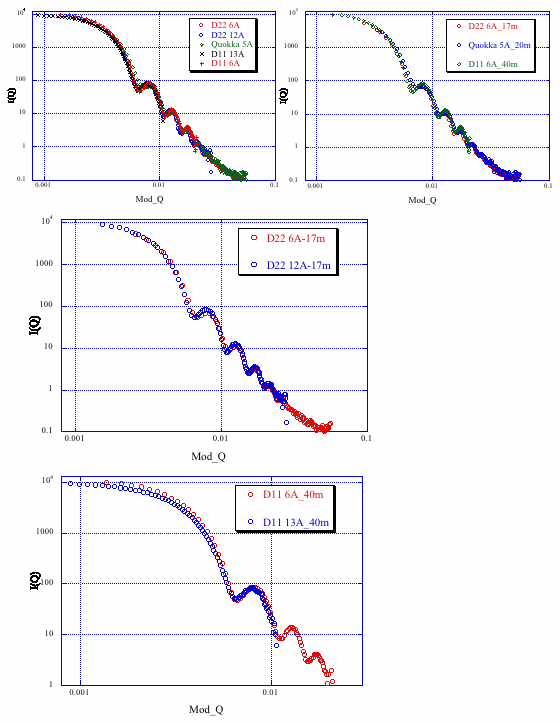Latex Round Robin: Difference between revisions
AdrianRennie (talk | contribs) |
AdrianRennie (talk | contribs) |
||
| Line 103: | Line 103: | ||
A sample with nominal concentration 0.5% has been measured with a sample-detector distance of 12 m. (This instrument uses a polychromatic beam in time-of-flight mode.) | A sample with nominal concentration 0.5% has been measured with a sample-detector distance of 12 m. (This instrument uses a polychromatic beam in time-of-flight mode.) | ||
Scattering Data | ====Scattering Data==== | ||
<nowiki>Sample Run Number </nowiki> | <nowiki>Sample Run Number </nowiki> | ||
| Line 113: | Line 113: | ||
<nowiki>D2O Solvent, 10514 </nowiki> | <nowiki>D2O Solvent, 10514 </nowiki> | ||
Transmission Data | ====Transmission Data==== | ||
<nowiki>Sample Run Number </nowiki> | <nowiki>Sample Run Number </nowiki> | ||
Revision as of 11:47, 30 April 2012
Samples
A polystyrene latex sample has been used for round robin measurements. As it is fairly monodisperse, it provides good tests for resolution. The hydrogenous polystyrene latex designated PS3 has been prepared in Uppsala (Materials Physics, Uppsala University) by Maja Hellsing.
Three samples at nominal concentrations of 0.4%, 0.1% and 0.025% designated A, B and C have been prepared in D2O with 1 mM added NaCl.
Measurements
At present (30 April 2012) the following instruments have been used for SANS measurements on the latex samples:
D22 at the ILL Grenoble, France
Data measured with a sample-detector distance of 17.6 m and an incident wavelength of 12 Angstrom and 6 Angstrom.
Sample Run Number Wavelength - 6 A
A, 50488
B, 50489
C, 50490
Solvent, 50491
E. Cell, 50487
Block Beam, 50492
Sample Run Number Wavelength - 12 A
A, 50506
B, 50507
C, 50508
Solvent, 50509
E. Cell, 50505
Block Beam, 50510
D11 at the ILL Grenoble, France
Data measured with a sample-detector distance of 34 m and an incident wavelength of 13 Angstrom and 6 Angstrom.
Data measured with a sample-detector distance of 8 m and an incident wavelength of 6 Angstrom.
Data measured with a sample-detector distance of 1.2 m and an incident wavelength of 6 Angstrom.
Sample, Run Number Wavelength - 13 A 34 m
A, 33427
B, 33428
Solvent, 33426
Sample Run Number Wavelength - 6 A, 34 m
A, 33418
B, 33419
C, 33420
Solvent, 33417
Sample Run Number Wavelength - 6 A, 8 m
A, 33410
B, 33411
C, 33412
Solvent, 33409
Sample Run Number Wavelength - 6 A, 1.2 m
A, 33379
B, 33480
C, 33481
Solvent, 33478
Quokka at ANSTO, Lucas Heights, Australia
Data measured with a sample-detector distance of 20 m and an incident wavelength of 5.08 Angstrom
SANS2D at ISIS, Didcot U.K.
A sample with nominal concentration 0.5% has been measured with a sample-detector distance of 12 m. (This instrument uses a polychromatic beam in time-of-flight mode.)
Scattering Data
Sample Run Number
0.5%, 10539
Empty Cell, 10571
D2O Solvent, 10514
Transmission Data
Sample Run Number
0.5%, 10498
Empty Cell, 10567
D2O Solvent, 10504
Direct Beam, 10484
Data Format
Contributors are encouraged to deposit their data using the cansas1d/1.0 XML data standard for 1-D SAS data within a ZIP or gzip archive file. A WWW form (canSAS/xmlWriter) is available to translate three-column ASCII text data into the canSAS1d/1.0 XML format.
Summary Plot
- Summary Plot Sample A
